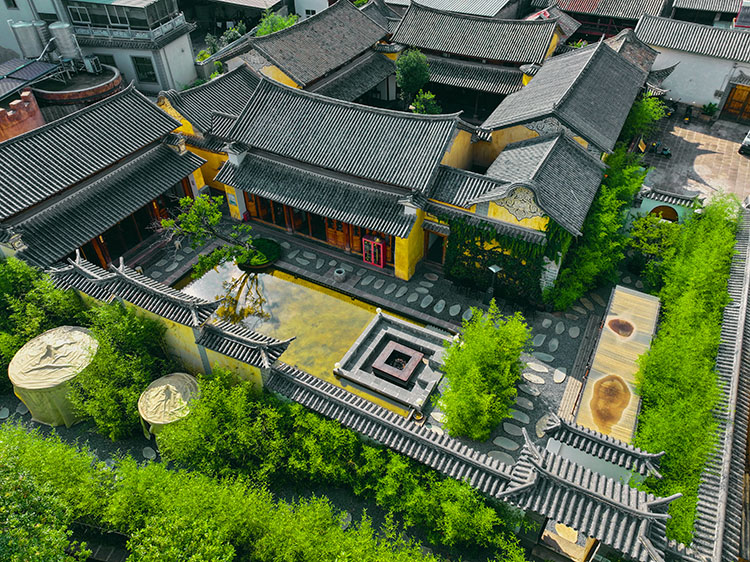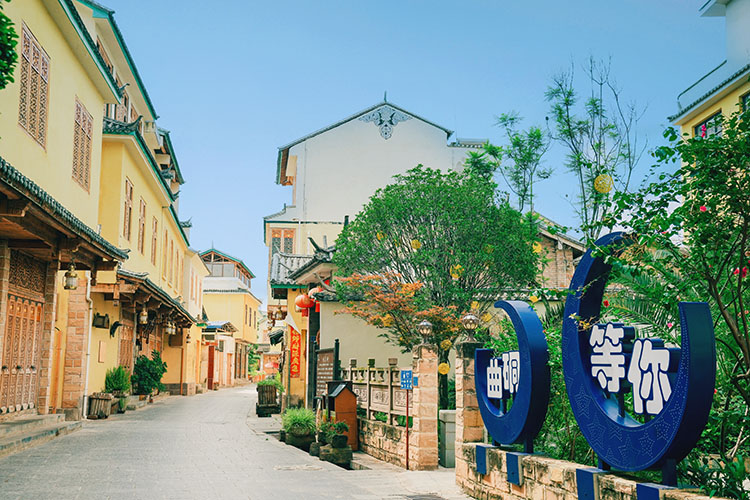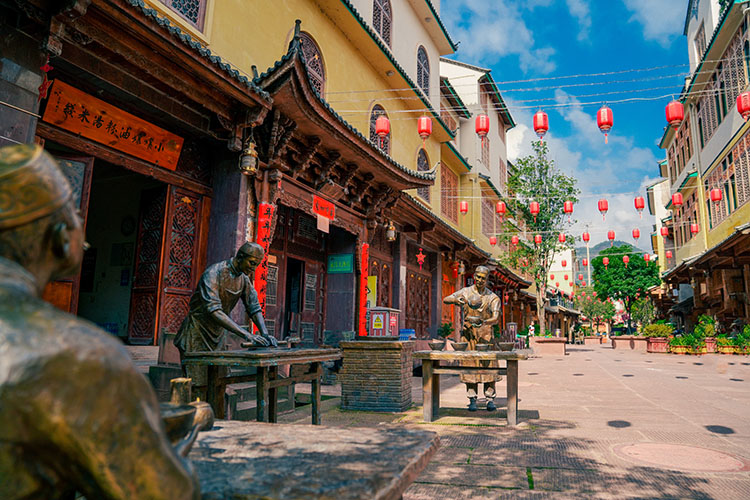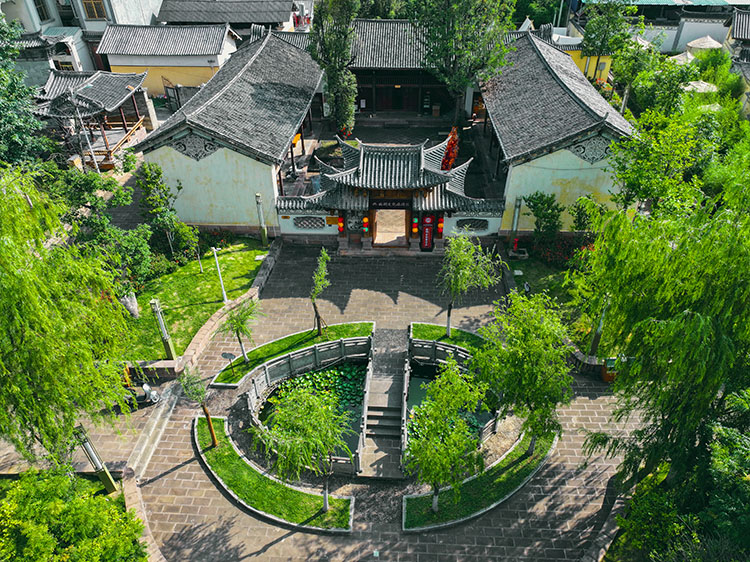Home Quadong cultural tourism area
Brief introduction of Quadong cultural tourism area
Qidong Cultural Tourism Zone belongs to Bonan Town, Yongping County, Dali Prefecture, Yunnan Province. It is 90 kilometers from Dali City in the west and 80 kilometers from Longyang District, Baoshan City in the east. In ancient times, it was an important post station on the Southern Silk Road, and now it is a necessary place on the Great Western Yunnan tourism Circle Line. Quadong has a long history, rich culture, outstanding location advantages, distinctive national culture, unique diet, complete street pattern preservation, rich geothermal resources, and has won the honorary title of Chinese traditional village, Chinese historical and cultural village, Chinese minority village, Yunnan Province gold medal tourism village, Yunnan Province's most beautiful nostalgia tourism destination. It is a tourist resort to explore the history of the Silk Road, experience the national culture, taste the special food, and recall the ancient nostalgia.

National culture square
The national culture square in the form of relief, column, concentric circles, not only depicts a vivid picture of multi-ethnic co-prosperity and harmonious development, but also shows the Quadong cultural tourism area has a long history, cultural diversity, national unity, the characteristics of rural civilization charm. The six pillars around the square represent the wisdom, diligence and pioneering spirit of six ethnic groups in Yongping County, namely Han, Yi, Hui, Miao, Bai and Lisu. The "concentric circle" brass relief in the center of the square not only symbolizes the unity and harmony among all ethnic groups in Yongping, but also shows the southern Silk Road stretching for thousands of miles, twists and turns of the route and geographical style. The relief on the cultural wall, respectively, tells the relationship between Xu Xiake, Guifu, Luo Hancai and other historical celebrities and Quadong culture, as well as the major historical stories that occur in Quadong this land, in order to cherish the memory of the ancien and inspire future generations.

Bonan Ancient Road
Bonan Ancient Road is the most distinctive section of the Southern Silk Road and is a national cultural relic protection unit. Ancient Road originated from the folk trade road of the 4th century BC -- Shu Dou Road, which developed into a government road in the reign of Emperor Wudi of Han Dynasty. After Bonan Road was installed in Bonan County by Emperor Ming in 69 AD, Bonan Road gradually replaced it. The Ancient Road in Yongping County is the only one section without fork in the Southern Silk Road. The total length of the county is 101 km. Bonan Ancient Road hiking route to Quadong cultural tourism area national culture square as the base camp, complete along the ancient villages, temples, temples and other cultural relics together, is the best hiking route to explore the ancient.

Former residence of Luo Han CAI
Luo Hancai (1872-1932), styled Yunwu, went to Yongchang to learn martial arts in the 18th year of Guangxu in the Qing Dynasty (1892 AD). Later, he turned to business and organized a caravan of more than 500 mules and horses, which spent many years in Burma, Thailand, Singapore and Southeast Asia. Influenced by Sun Yat-sen's thought of democratic revolution, in order to support the democratic revolution, most of the funds accumulated over the years were donated to the revolutionary Party as activity funds. Huang Xing, the pioneer and leader of the revolution of 1911, in order to show his revolutionary achievements, he gave a special couplet: Siam to supplement Zhongshan donated funds to prepare weapons to overthrow the imperial system and apply for great justice; Lock sand to defend the western frontier to raise grain to build an army to support democracy. In the first year of the Republic of China (1912), Luo Hancai was appointed by Tang Jiyao, governor and governor of Yunnan Province, as deputy governor of Yunnan Province, army command and other positions, and returned to his hometown due to illness, succeeding Yongping County defense brigade commander. In his later years, Luo Hancai organized and initiated the "Yongping County Simple Normal School" regardless of illness. In 21 years of the Republic of China (1932 AD), Luo Hancai died of illness at the age of 60. The former residence of Luohancai is one of the ancient courtyards in Quadong cultural tourism area, which is currently preserved and relatively complete. It was built in the 11th year of the Republic of China (1922), and is a typical "six contract spring" residential building, which is called by the locals as "sesame flower's stone horn, tiger's eye stone's column foot, four and five courtyards, walking horse string attic". It belongs to the Bai nationality residential style, and the whole courtyard layout is symmetrical and the design is scientific. With rigorous structure, excellent materials and exquisite workmanship, it can be called the treasure of Yongping folk courtyard architecture since modern times.
millstone
Water for the simple Quadong cultural tourism area to give the spirit, the history of Quadong village, developed water system in addition to farmland irrigation, landscape construction, the villagers also through sufficient water energy, the use of ditches high and low, has built two water mills, two water mills, water mill 1, as the village food centralized processing workshop. After a thousand years of inheritance, with the rise of the power processing industry, water mills, water treadmills and water grinders gradually withdrew from the historical stage. In order to retain the memory of history, the villagers will be abandoned stone mill, stone roller inlaid in the center of the road of the ancient town, as a physical witness of farming civilization, but also for future generations to retain an ancient nostalgia.
Yongping county simple normal school

Yongping County Simple Normal School is a famous patriotic squire, Tongmenghui member Luo Hancai in order to change the lack of talent in his hometown, backward education, organized in 1930, built in 1932 full-time school. From its establishment in 1930 to its merger in 1950, the school has enrolled 8 classes with more than 380 students. Five classes graduated with 266 students.
The establishment of Yongping County Simple Normal School has trained a large number of talents for Yongping and the surrounding areas, and also laid a solid foundation for national education in Yongping. In 36 years of the Republic of China (1947), Yin Wende, then the county governor, led the county's celebrities and gentry to erect a monument in the school to commend Mr. Luo Hancai's outstanding contribution to the democratic revolution, his concern for the education cause in his hometown, and his founding of the county simple normal School.
The Southern Silk Road
There are three "Silk Roads" in China's history, one is the northern land Silk Road, one is the maritime Silk Road, and the other is the southern land Silk Road. Among them, the southern Silk Road has the longest history, which was opened as early as the fourth century AD, more than two centuries ahead of the opening of the northern Silk Road. The Southern Silk Road is not only a military artery, but also an international commercial traffic line, from east to west through the Quadong cultural tourism area of the "Bonan Ancient Road" is an important section of the Southern Silk Road. The thousand-year ancient road not only created the long history of Quadong, but also led to the prosperity of commerce and trade in Quadong. The local residents have created a rich and diverse national culture through the interaction and integration with the merchants and other ethnic groups from south to north.
Horse peg
Hitching post is the ancient and modern rich family tied to the mule stone, generally with a solid and wear-resistant block of bluestone carved, wide and thick, about 22 to 30 cm, often planted on the left and right sides of the residential gate. Delicate hitching posts, often carved with lifelike, naive animal or human figures on the top. It is not only the organic composition of the house building, but also like the stone lion carving in front of the door, it has the role of decorating the building to show off the rich, and at the same time, it has been given the special meaning of the town house to ward off evil, and is known as "the house of the village". The hitching pile scattered in Quadong village is the biggest difference with the Central Plains area is simple and simple in shape, focusing on economic and practical.
Shangmaishi
In ancient times, large families had to set two boulders in front of the house door, one for the horse stone, one for the horse stone, the horse stone because of language taboo, it is commonly called the horse stone. Shang horse stone originated in the Qin and Han dynasties. According to legend, Wang Mang of the Western Han Dynasty was short and difficult to mount and dismount, so he began to erect Shang horse stone, which gradually became a fashion. Especially in the Qing Dynasty, it was most popular and became a symbol of status and wealth. Shangma stone is about 60 cm high, generally bluestone material, carved with delicate bird and animal flower patterns. And scattered in the Quadong ancient town of Shangma stone, mostly ordinary red stone material, no pattern, emphasis on practical, which also reflects the Quadong people frugal and honest style of doing things.
Guanjia Lane
Guanjia Lane has a long history and profound cultural accumulation. It is one of the most representative ancient lanes in Quadong Town. It is named for many local officials. In the ancient town of Quadong winding back, winding path of many lanes, Guanjia lane is an exception, with the lane straight wide respect, easy to enter and exit famous. On both sides of the roadway, there were scattered a number of ancient residential courtyards with the architectural pattern of "four and five courtyards" and "three courtyards". Most of these buildings have the characteristics of combining Han culture and Islamic culture, among which the former residence of Ma Shuangyuan, a local celebrity, is the most representative, and the housing layout and building scale are comparable to the former residence of Luo Hancai.
Eight treadle-operated tiller
Guyi Qu Adit, backed by Bonan mountain, in front of the silver River, the village ditches covered, water with the lane, the villagers use the power of water height difference, has built in the village 6 water mills, water mill 2, water mill 1, between the size of the east gate has built 4 water mills, each stump has two, four there are a total of eight trippers. For a long time, people are used to calling this place Bazhang-dul, and the scenery moves at any time. With the prosperity of the country and the development of the power processing industry, water-dul, water-grinding and water-grinding have gradually withdrawn from the historical stage, but the name of Bazhang-dul has left a historical memory and retained an unforgettable nostalgia.
Ancient well
Many ancient Wells are distributed in many deep streets and alleys and ancient houses in Quadong. These Wells are deep and shallow, and some are no longer in use, but most of the ancient Wells still provide people with fresh and sweet spring water. More than a dozen ancient Wells of more than 100 years, such as Dongmen Old well, Garden old well, Shanglan Old well and Xiaolong Well, are still well preserved. The walls of these ancient Wells are either light and smooth, or long with thick moss, which are ancient memories that cannot be erased. Quadong's ancient Wells have a common feature - a small mouth with a wide heart, the well head to a whole piece of hard rock pierced into, only a special "water" small bucket up and down. Small mouth, both to prevent people and animals from falling, but also to save water effect, wide heart, the interior is like a large belly of the soil urn, water storage. These ancient Wells and streets and canals form a complete water system of ancient villages in Quadong, bearing the history and culture, witnessing the farming civilization, which is the memory of nostalgia that cannot be given up.
Fushun horse shop
Quadong is an important hub and material distribution center on the Southern Silk Road, a traffic throat to Baoshan, Nujiang and Dehong in western Yunnan, and an important traffic gateway to Myanmar, India and other South Asian countries. The unique traffic location and superior natural conditions promote the caravan from south to north to often stop here. By the end of the Qing Dynasty, 70% of the villagers in Quadong also made a living by driving horses for transportation, and took the life of the horse gang as their business, forming some small-scale horse gang groups. In the 25th year of the Republic of China (1936), the village had a total of Luo Hancai, Ma Zhenbang, Ma Chaohua, Ma Lianjun and other sizes of pot head more than 30 POTS, each pot had 50~90 horses, a total of more than 2,000. With the progress of The Times and the rapid development of modern means of transportation, the ancient road is dusty, the gang is no longer, and the horse shop has gradually withdrawn from the stage of history, only the deep horseshoe prints on the SLATE are still telling the prosperity of the year.
The old Halal Temple
Qidong Mosque, in 2013 was listed as state-level cultural relics protection units, was built in the Ming Dynasty, the Republic of China two years (1913) relocation into the existing temple. The whole temple is a three-chamber building layout, the inner court has the main hall, called the worship tower, the north and south two wings, the main building of the outer court is the gate tower, there are also north and south wings, the overall architectural style is the warped corner rest hilltop type. The main hall sits west to east, five open room, through the open room 20 meters, through the depth of 15 meters, sharing 60 columns, wooden frame lifting beam structure. The building of the whole mosque is grand and solemn, beautiful and simple, covers an area of 3024 square meters, and the existing building area is 1200 square meters. Although it has been repaired, it still retains the architectural heritage of Ming and Qing dynasties. Let the world know Yongping, know the qu adit.
Dianpu Park

Dian Park, founded in the Yuan Dynasty, has a history of more than 700 years, save 57 trees more than three hundred years old Dian simple ancient wood, luxuriant branches, shady dancing, spreading the vigorous vitality of life, witness the ancient village of Quadong "past life".
The garden also embodies the miniature of Quadong Hui funeral customs. Hui funeral emphasizes "thick and thin burial", with three characteristics of quick burial, thin burial and earth burial, and the funeral is simple and solemn. Hui called the dead "Guizhen", first of all according to the gender of the "Guizhen" people, please understand the classic experienced men and women, with a "soup pot" filled with warm water from head to foot rinse, after bathing, with three zhang six white cloth wrapped, convenient transport of the body on the waist tied a white tape, head and feet also tied with white cloth. If the "return" is a woman, it is necessary to add a headcloth and a chest bundle, and then put the "return" person into the "Bible box" and send the male relatives and friends to the cemetery for burial. In the cemetery, the funeral ceremony should be held by A crawl rate, praying, chanting scriptures, and praying for the "return" people. Its burial grave is two meters deep, and a side hole is dug on the west wall of the straight pit, with a height of about one meter and a long accommodating body. After placing the deceased's head in the north and feet in the south, facing the west, the opening was sealed with bricks, and then the straight pit was filled, and the ground was piled into a fish-ridge graveyard. The structures built on the glass roof in the garden were the intuitive display of Hui burial tombs. The Hui funeral fully embodies the characteristics of equality, frugality and hygiene.
Bridge of service
Quadong is an important post station and material distribution center on the Southern Silk Road. Since ancient times, the villages along the ancient Silk Road, including Quadong, have the tradition of "taking Yi Fang". The men either drove their own caravans or traveled along the ancient Silk Road to Burma and other Southeast Asian regions to make a living as traders. The men who walk Yi side are both for the son of man and for the husband and father, and many women who worry about their hearts always habitually send men to the bridge at the entrance of the village, reminding and ordering them, and then reluctantly turn back. Until the end of the year, the small stone bridge at the entrance of the village has become a place for women to watch the return of their loved ones. As time went by, people called the small stone bridge the Lang Lang Bridge.
Ma Mingxun
Ma Mingxun, the word Zhong Hou, Qing Guangxu years scientific examination into tribute. In the 13th year of the Republic of China (1924), he was elected a member of the Yunnan Provincial Council. In the 17th year of the Republic of China (1928), he was elected the fourth Senator of the Yunnan Provincial Council. Nineteen years of the Republic of China (1930), served as the county magistrate of Jianchuan County.
Ma Mingxun learned, love home, sense of the people, public opinion, is Yongping Qu Adit cultural celebrity. His poems are numerous and influential. Among them, "Shishan Yin" expressed his attachment and praise to his hometown Quadong: "I love little Shishan, Qingqing face to face." At that time, people did not know that the mountain was strange, but they often met the mountain. Lion mountain look the most hero, from Junshan vision empty. And east Qiuyin River, Qi Yu Xuan ring is different. Beyond the mountains no bozhong, a peak independent adjacent tunnel. The red horse and the dragon plate, and if this mountain alone outstanding." Another "Yongchang Fu Wen Zheng" entry "Seven rules · Zhang Zhonglie Temple", deeply expressed his love and hate clearly, respect the martyrs of the emotion.



